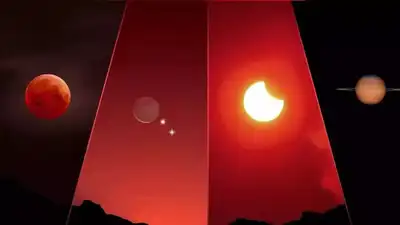ARTICLE AD BOX

On the night of September 7-8, 2025, millions across Asia, Africa, Europe, and Australia will witness a stunning
total lunar eclipse
, famously called a Blood Moon. This celestial event is remarkable for its exceptional duration—one of the longest total lunar eclipses in a decade. The totality phase, where the Moon is completely immersed in Earth’s shadow and glows a deep red, will last approximately 82 minutes. This extended length is due to the Moon’s slow movement near its apogee and its central passage through Earth’s umbra, the darkest part of the shadow. This rare and captivating event offers skywatchers ample time to experience and enjoy one of nature’s most beautiful astronomical phenomena.
Understanding lunar eclipses: Why is it called a 'blood moon'
A lunar eclipse occurs when the Earth moves directly between the Sun and the Moon, casting its shadow on the Moon’s surface. This event can only take place during a full moon, when the Sun, Earth, and Moon are perfectly aligned in a straight line.Earth’s shadow consists of two parts:
- Penumbra: The lighter, outer shadow where sunlight is partially blocked.
- Umbra: The darker, central shadow where sunlight is completely blocked.
During a total lunar eclipse, the Moon passes entirely into the umbra, causing it to darken dramatically. However, the Moon doesn’t turn pitch black—instead, it takes on a deep red or coppery hue, giving rise to the term Blood Moon.
Lunar eclipse 2025: When and where to watch September blood moon
The total lunar eclipse of September 7-8, 2025, will unfold over several hours, offering a spectacular show visible to billions across the globe.Key timings for India (IST)
- Penumbral eclipse begins: 8:58 PM, September 7
- Partial eclipse begins: 9:57 PM
- Total eclipse begins (Blood Moon phase): 11:00 PM
- Maximum eclipse: 11:41 PM
- Total eclipse ends: 12:22 AM, September 8
- Partial eclipse ends: 1:26 AM
- Penumbral eclipse ends: 2:25 AM
Blood moon 2025: Best visibility across the world
- Asia: India, China, Japan, Southeast Asia
- Australia: Western Australia and surrounding regions
- Africa: Most parts of the continent
- Europe: Eastern and Central Europe (seen near moonrise)
Partial or limited visibility
- Eastern Europe and New Zealand will catch parts of the eclipse during moonrise or moonset.
- Western Canada and Alaska may see the eclipse's final moments near moonset.
Areas where the eclipse won’t be visibleMost of North America, including the continental United StatesEastern South AmericaSkywatchers in these regions can still enjoy the event via live streams hosted by astronomy observatories worldwide as reported.
Why does the moon turn red during a lunar eclipse
The red coloration is caused by Rayleigh scattering. As sunlight passes through Earth’s atmosphere, shorter wavelengths of light (blue and green) are scattered out, while longer wavelengths (red and orange) bend around the Earth and illuminate the Moon. This is the same reason why sunsets and sunrises appear red, bathing the Moon in a haunting reddish glow during totality.
Why is the 7 September 2025 lunar eclipse one of the longest in 10 years
The 7 September 2025 lunar eclipse is one of the longest in a decade due to a rare combination of astronomical factors. The Moon will be near apogee, its farthest point from Earth, causing it to move more slowly and spend more time passing through Earth’s shadow. Additionally, it will take a deep, central path through the umbra, Earth’s darkest shadow, maximizing the total eclipse duration to 82 minutes. A nearly perfect alignment between the Sun, Earth, and Moon enhances this prolonged totality. Adding to its significance is its broad visibility—around 87% of the global population across Asia, Africa, Europe, and Australia will be able to witness at least part of this spectacular Blood Moon event.
How to watch the Blood Moon on 7-8 September 2025: Viewing tips
- No special equipment needed
Unlike solar eclipses, lunar eclipses are safe to watch with the naked eye. You don’t need special glasses or filters to enjoy the Blood Moon’s eerie red glow.
Cities like Delhi, Mumbai, Kolkata, and Bengaluru in India will have clear views of the entire eclipse. The Moon will be high in the sky in Asia and Australia, making it ideal for casual viewers and photographers.
With 82 minutes of totality, photographers have plenty of time to capture stunning images of the Moon’s crimson transformation. Use a camera with a telephoto lens or a telescope for the best results, though even smartphone cameras can capture the event under clear skies.
What happens during the total lunar eclipse
As the Moon moves into Earth’s shadow, it will gradually darken. During totality, the Moon glows a reddish-orange color due to sunlight bending through Earth's atmosphere. This lunar eclipse occurs just 2.7 days before the Moon reaches perigee (its closest approach to Earth), making the Moon appear slightly larger and brighter than usual.
- One of the longest total lunar eclipses in 10 years, lasting 82 minutes of totality.
- A stunning Blood Moon with a deep red hue caused by Earth's atmosphere.
- Visible across Asia, Africa, Europe, and Australia with no need for special viewing equipment.
- Offers a rare opportunity to witness a rare and spectacular celestial event visible to billions.
- Ideal for skywatchers, photographers, and astronomy enthusiasts.



.png)
.png)
.png)
















 3 days ago
8
3 days ago
8







 English (US) ·
English (US) ·